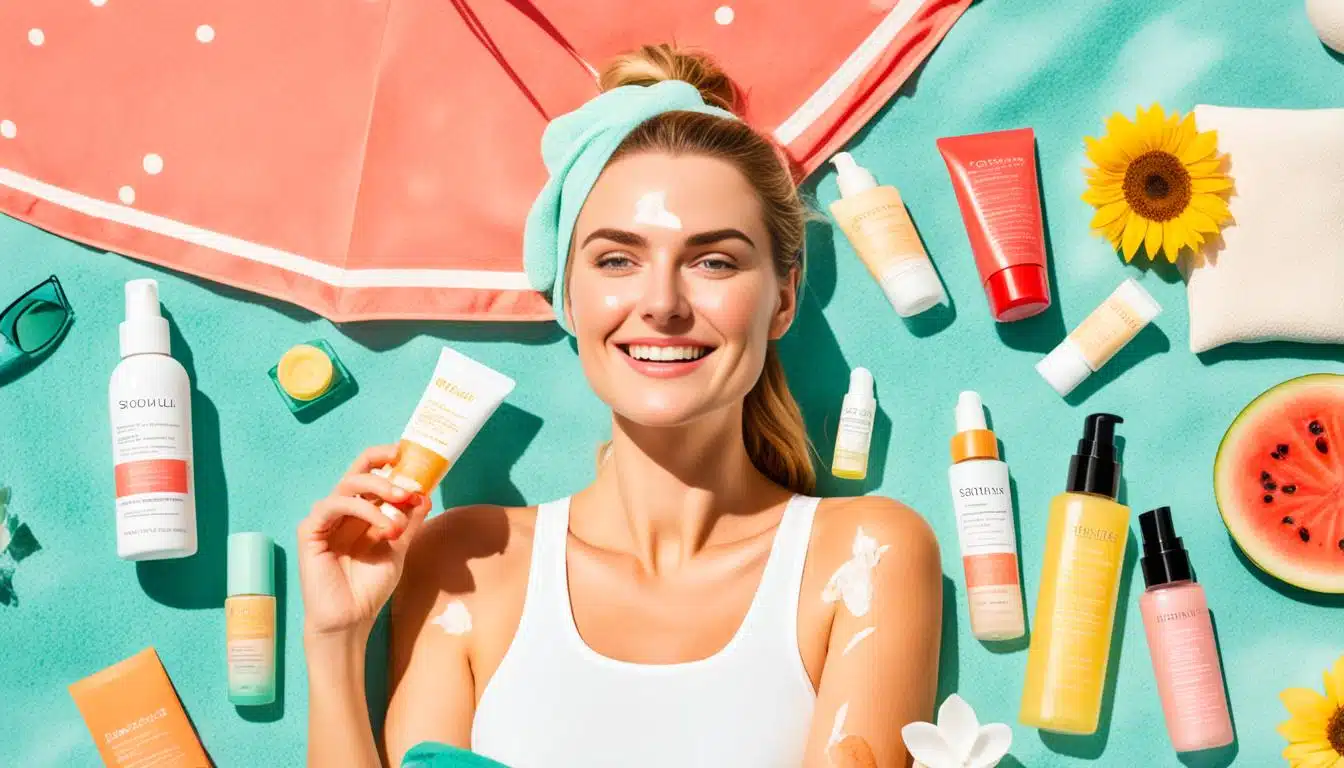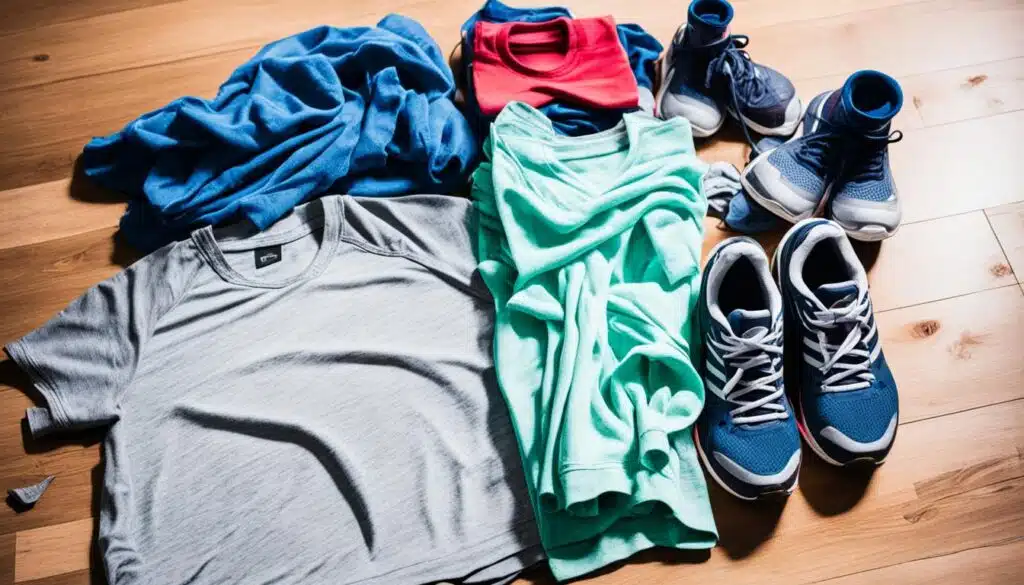Skincare Tips For Summer is the season when our skin needs extra care due to various factors like sun exposure, sweating, and increased humidity. To ensure your skin stays healthy and radiant during the summer months, follow these expert skincare tips.
Protecting your skin from harmful UV rays is essential. Wear sunscreen with SPF 30 or higher to safeguard your skin from the risk of skin cancer and sunburn. Select a moisturizer that suits your skin type and helps maintain its natural hydration. Exfoliation is key to removing dead skin cells and unclogging pores, allowing your skin to breathe and stay fresh. Remember to reapply sunscreen every two hours, especially if you’re sweating or swimming.
Hydration is crucial in summer, as excessive sweating can dehydrate your skin. Drink plenty of water throughout the day to ensure your skin stays hydrated from the inside out. Incorporate vitamin C into your skincare routine to combat free radicals and boost collagen production. Cleanse your face twice a day to remove impurities and keep your skin healthy and glowing.
Be proactive in preventing signs of aging, such as fine lines and wrinkles. Use lip balm or lipstick with SPF to protect your lips from sun damage. It’s important to take care of your skin barrier as it plays a significant role in maintaining skin health. Avoid excessive exfoliation and use gentle products that won’t strip away natural oils.
With these summer skincare tips, you can achieve and maintain healthy, radiant, and glowing skin all season long.
Key Takeaways: Skincare Tips For Summer
- Protect your skin from harmful UV rays by wearing sunscreen with SPF 30 or higher.
- Choose a moisturizer that suits your skin type to keep it hydrated.
- Exfoliate regularly to remove dead skin cells and unclog pores.
- Reapply sunscreen every two hours, especially when sweating or swimming.
- Stay hydrated by drinking plenty of water.
Check Your Moles Regularly to Detect Skin Changes
Regularly checking your moles is an important step in monitoring your skin health, especially if you spend a significant amount of time in the sun. By being proactive and observant, you can detect any changes in your moles that could be a potential sign of skin cancer.
It is highly recommended to visit a dermatologist for a thorough full-body exam, as they are experts in identifying and diagnosing skin conditions. A dermatologist can systematically examine your moles and assess any areas of concern, providing you with peace of mind and valuable guidance.
Early detection is key in the fight against skin cancer. By regularly checking your moles and consulting a dermatologist, you can ensure that any potential issues are addressed promptly. This proactive approach greatly increases the chances of staying melanoma-free and maintaining healthy skin.
Remember, prevention is always better than cure when it comes to skin cancer. Take control of your skin health by checking your moles regularly and consulting a dermatologist for regular screenings.
Understanding the Importance of Regular Mole Checks
Certain factors, such as excessive sun exposure, can contribute to changes in the appearance and characteristics of moles. These changes include variations in color, size, shape, and texture. Checking your moles regularly allows you to monitor these changes and seek medical attention if necessary.
While not all changes in moles indicate skin cancer, it’s still crucial to be vigilant. By including mole checks as part of your regular skincare routine, you can stay proactive in protecting your skin and catching any potential issues before they develop into more serious conditions.
- Sun Exposure and Moles: Because moles are often a result of sun exposure, it is important to be mindful of any changes that may occur. Protecting your skin from excessive sun exposure, using sunscreen, and wearing protective clothing are all essential in preventing skin damage and reducing the risk of developing abnormal moles.
- Self-Examination: Take the time to examine your moles regularly using a full-length mirror and a handheld mirror. Look for any changes in size, shape, color, or texture. If a mole becomes irregular, itchy, painful, or starts to bleed, it is important to consult a dermatologist immediately.
- Mole Mapping: In some cases, your dermatologist may recommend mole mapping, a comprehensive process using specialized imaging technology to track and document the appearance of your moles over time. This is particularly beneficial for individuals with a large number of moles or a history of skin cancer.
Wear Sunscreen with the Recommended SPF
Protecting your skin from the harmful effects of the sun is crucial, and sunscreen plays a vital role in achieving this. When choosing a sunscreen, it is recommended to opt for a product with a minimum SPF of 30 or higher. While the FDA states that SPF 15 is the minimum requirement, experts emphasize the importance of using SPF 30 or higher for better protection against skin cancer and skin photoaging.
Applying sunscreen with the recommended SPF can significantly reduce the risk of developing skin cancer and experiencing dark patches caused by sun exposure. Sunscreen acts as a barrier between your skin and the harmful ultraviolet (UV) rays, preventing them from penetrating the skin and causing damage.
To ensure maximum effectiveness, apply sunscreen at least 30 minutes before sun exposure to allow it to properly absorb into your skin. Reapply every two hours, especially if you’ve been sweating or swimming, as the product can wear off over time.
Remember that sunscreen should be used in conjunction with other sun protection measures, such as seeking shade during peak sun hours and wearing protective clothing. By incorporating sunscreen with the recommended SPF into your daily skincare routine, you can safeguard your skin from the harmful effects of UV rays and maintain its health and vitality.
Stay in the Shade to Prevent Sun-Induced Wrinkles and Dark Patches
Spending prolonged periods under the sun can have damaging effects on your skin, including sunburn, the formation of sun-induced wrinkles, and the development of dark patches. To protect your skin from these issues and maintain a more youthful appearance, it is crucial to prioritize shade and minimize direct sun exposure.
When spending time outdoors, especially during the peak sun hours, seek shade or create your own using an umbrella or hat. This will help block the harmful UV rays that can cause sunburn and contribute to the formation of wrinkles. By staying in the shade, you can reduce the risk of skin damage and maintain a smoother, more resilient complexion.
“The shade is your skin’s best friend when it comes to preventing sun-induced wrinkles and dark patches. By minimizing your exposure to direct sunlight, you are protecting your skin from harmful UV rays and preserving its youthfulness.” – Dr. Emily Johnson, Dermatologist
Remember, even on cloudy days, UV rays can still penetrate your skin, so it is essential to seek shade whenever possible. By prioritizing shade and minimizing direct sun exposure, you can significantly reduce the risk of sunburn, the appearance of wrinkles, and the development of dark patches on your skin.
Benefits of Staying in the Shade:
- Prevents sunburn and reduces the risk of skin cancer
- Helps maintain the integrity of the skin’s collagen and elastin fibers, preventing the formation of wrinkles
- Reduces the production of melanin, preventing the development of dark patches and hyperpigmentation
- Preserves the skin’s natural moisture, preventing dryness and dehydration
To visually reinforce the importance of staying in the shade, here is a table comparing the effects of sun exposure with and without shade:
| Effects of Sun Exposure | Without Shade | With Shade |
|---|---|---|
| Sunburn | More likely | Less likely |
| Sun-induced wrinkles | More prominent | Reduced appearance |
| Dark patches | More likely to develop | Less likely to develop |
As you can see from the table, staying in the shade can significantly reduce the negative effects of sun exposure on your skin, helping you maintain a more youthful and even complexion.
Moisturize Your Skin after Sun Exposure
Sun exposure can leave your skin feeling dehydrated and dull, especially when combined with sand and salty water. To restore your skin’s moisture levels and keep it healthy and radiant, it’s essential to moisturize your skin after sun exposure. Using a highly moisturizing body lotion and face moisturizer can help bring balance back to your skin and prevent dryness caused by external elements.
Choose a moisturizer that is suitable for your skin type and contains hydrating ingredients like hyaluronic acid or ceramides. These ingredients help to replenish the skin’s moisture barrier and lock in hydration. Apply the moisturizer liberally all over your body, focusing on areas that are most prone to dryness, such as elbows and knees.
For your face, opt for a moisturizer that is lightweight and non-comedogenic to avoid clogging your pores. Look for formulas that contain soothing ingredients like aloe vera or chamomile to calm any redness or irritation from sun exposure.
In addition to using a moisturizer, consider incorporating a hydrating face mask into your skincare routine once or twice a week. These masks provide an extra boost of hydration and nourishment to your skin, helping to combat the effects of sun exposure.
Expert Tip: After applying your moisturizer, gently massage your skin in upward circular motions. This helps to promote blood circulation and absorption of the moisturizer for maximum effectiveness.
Remember, moisturizing your skin after sun exposure is crucial to prevent dehydration and maintain its natural moisture balance. By incorporating this step into your post-sun skincare routine, you can help keep your skin healthy, hydrated, and glowing all summer long.
Take Cool Showers to Keep Your Skin Hydrated
Hot showers can be soothing, but did you know they can also dehydrate your skin? If you want to maintain optimal skin hydration levels, it’s time to switch to cool showers. Cool water is refreshing and can help prevent moisture loss, keeping your skin supple and well-hydrated.
Cool showers offer more than just hydration. When you expose your skin to cool water, it stimulates better blood flow and promotes skin microcirculation. This improved circulation helps deliver essential nutrients and oxygen to the skin cells, enhancing overall skin health and giving you that radiant, healthy glow.
To enjoy the benefits of cool showers, simply turn down the water temperature and let the cool water cascade over your body. You’ll feel refreshed and invigorated, all while taking care of your skin.
So, the next time you step into the shower, remember to opt for a cool shower and experience the positive effects it can have on your skin’s hydration, blood flow, and skin microcirculation.
Benefits of Cool Showers:
- Prevent dehydration and maintain skin hydration
- Stimulate better blood flow
- Promote skin microcirculation
- Deliver essential nutrients and oxygen to the skin
- Enhance overall skin health and radiance
Change Your Clothes After Sweaty Physical Activity
We all know how satisfying it feels to complete a sweaty workout or intense physical activity. But did you know that staying in sweaty or wet clothes for too long can have negative effects on your skin? When you exercise, you may not realize how much sweat your body produces, especially in the hot summer months. This excess sweat can create a favorable environment for bacteria to thrive, leading to skin issues like folliculitis, which is inflammation of the hair follicles. So, to prevent these unwanted skin problems, it’s important to change your clothes and wash them promptly after engaging in sweaty physical activities.
When you leave sweaty clothes on your body, the moisture and warmth create an ideal breeding ground for bacteria. As they multiply, they can cause skin inflammation and infections, resulting in conditions like folliculitis. Folliculitis presents as red, itchy bumps around hair follicles and can be uncomfortable and unsightly.
To maintain the health and cleanliness of your skin, it is crucial to change out of your sweaty clothes as soon as possible. By removing the sweaty garments, you eliminate the bacteria-laden environment and give your skin a chance to breathe and recover.
After changing, it’s important to wash your clothes thoroughly. This will help remove any lingering bacteria, sweat, and odor from the fabric. Utilize a detergent that is suitable for your clothing materials and follow the instructions for a proper wash. By incorporating this simple step into your routine, you can minimize the risk of skin inflammation, infection, and other associated skin issues.
Remember, taking care of your skin goes beyond skincare products and treatments. Something as straightforward as changing out of sweaty clothes can significantly contribute to keeping your skin healthy and free from issues like folliculitis. So, the next time you finish a sweaty workout, make sure to prioritize changing into clean, dry clothes to maintain the overall health and well-being of your skin.
Disclaimer: The image above is for illustrative purposes only and may not depict the exact scenario described in the section.
Use Revitalizing Masks Once a Week for Skin Repair
Revitalizing masks are an excellent addition to your skincare routine, providing multiple benefits for your skin. These masks offer a unique combination of ingredients and formulations that can help restore skin balance, enhance skin texture, and improve overall appearance.
By using revitalizing masks once a week, you can give your skin the extra care it needs for repair and rejuvenation. These masks are designed to provide essential hydration, replenish moisture, and boost skin elasticity. They work by infusing your skin with nourishing ingredients that penetrate deeply to address specific concerns and revitalize your complexion.
A key benefit of revitalizing masks is their ability to repair and strengthen the skin barrier. The skin barrier plays a crucial role in maintaining overall skin health and protecting it from external stressors, such as pollution and harsh weather conditions. By using a mask that supports skin barrier function, you can help restore balance and resilience to your skin.
Improving skin texture is another advantage of incorporating revitalizing masks into your skincare routine. These masks often contain exfoliating ingredients that gently remove dead skin cells and promote cell turnover, resulting in a smoother and more refined complexion. Regular use of these masks can also help minimize the appearance of pores and improve skin tone.
When selecting a revitalizing mask, look for one that suits your skin type and addresses your specific concerns. Whether you’re looking to hydrate dry skin, balance combination skin, or soothe sensitive skin, there are masks available for every skin concern.
Here are some popular types of revitalizing masks:
- Hydrating masks: These masks are formulated with ingredients like hyaluronic acid and aloe vera to deeply moisturize and plump the skin.
- Brightening masks: These masks contain ingredients like vitamin C and niacinamide to improve skin tone and reduce the appearance of dark spots.
- Exfoliating masks: These masks often contain alpha hydroxy acids (AHAs) or enzymes that gently remove dead skin cells and reveal a smoother complexion.
- Detoxifying masks: These masks help draw out impurities and excess oil from the skin, leaving it feeling clean and refreshed.
To incorporate a revitalizing mask into your routine, follow these steps:
- Cleanse your face thoroughly and pat dry.
- Apply the mask evenly to your face, avoiding the eye and lip area.
- Leave the mask on for the recommended time, usually around 15-20 minutes.
- Rinse off the mask with lukewarm water and gently pat your face dry.
- Follow up with your regular skincare routine, including moisturizer and sunscreen.
Remember, consistency is key when using revitalizing masks. Aim to use the mask once a week to reap the maximum benefits and achieve healthier, more radiant skin. Make it a relaxing self-care ritual and enjoy the rejuvenating effects of these masks.
| Product | Main Benefits | Key Ingredients | Suitable for Skin Types |
|---|---|---|---|
| Brand A | Hydration, Brightening | Hyaluronic acid, Vitamin C | Dry, Normal, Combination |
| Brand B | Exfoliation, Pore Refining | Alpha hydroxy acids (AHAs), Salicylic acid | Combination, Oily, Acne-prone |
| Brand C | Soothing, Anti-Redness | Calendula extract, Aloe vera | Sensitive, Dry, Normal |
| Brand D | Detoxification, Oil Control | Charcoal, Kaolin clay | Oily, Combination, Acne-prone |
Harness the Power of Antioxidants for Skin Protection
UV radiation from the sun is a significant source of free radicals that can damage our skin and contribute to premature aging. To protect your skin from these harmful effects, it’s essential to incorporate antioxidants into your diet and skincare routine.
Foods rich in vitamin C, such as citrus fruits, berries, and leafy greens, provide natural antioxidants that can help neutralize free radicals and protect your skin from oxidative stress. Additionally, consider using skincare products that contain antioxidants like ascorbic acid and free-radical scavenging peptides.
Antioxidants work by counteracting the damaging effects of free radicals, which are unstable molecules that can cause oxidative stress and accelerate the skin aging process. By incorporating antioxidants into your skincare routine, you can combat the harmful effects of UV radiation and maintain healthier, more youthful-looking skin.
“Antioxidants work by counteracting the damaging effects of free radicals, which are unstable molecules that can cause oxidative stress and accelerate the skin aging process.”
When using skincare products with antioxidants, look for serums or creams that specifically target UV damage and provide protection against free radicals. These products can help reduce the appearance of fine lines, wrinkles, and other signs of aging caused by UV radiation.
Remember that protecting your skin from UV radiation goes beyond sunscreen. While sunscreen is crucial for shielding your skin from harmful rays, incorporating antioxidants into your skincare routine can provide an additional layer of protection and help mitigate the damaging effects of UV exposure.
The power of antioxidants can be harnessed both internally and externally to boost the health and resilience of your skin. By incorporating antioxidant-rich foods into your diet and using skincare products that contain antioxidants, you can protect your skin against oxidative stress and maintain a youthful, glowing complexion.
The Benefits of Antioxidants for Your Skin
| Benefit | Description |
|---|---|
| Reduces Wrinkles and Fine Lines | Antioxidants help stimulate collagen production, which can help reduce the appearance of wrinkles and fine lines. |
| Improves Skin Texture | Antioxidants can help improve the overall texture of your skin, making it smoother and more radiant. |
| Enhances Skin Firmness | By protecting the skin from free radicals, antioxidants can help improve skin firmness and elasticity. |
| Reduces Hyperpigmentation | Antioxidants can help even out skin tone and reduce the appearance of dark spots and hyperpigmentation. |
| Soothes Irritated Skin | Antioxidants have anti-inflammatory properties that can help soothe and calm irritated skin. |
By harnessing the power of antioxidants, you can protect your skin from the damaging effects of UV radiation, combat premature aging, and maintain healthy, youthful-looking skin.
Also Read: Exploring The Hair-Nourishing Advantages Of Fish Oil
Conclusion
Taking care of your skin during the summer months is crucial for maintaining healthy and glowing skin. By following a consistent summer skincare routine, you can protect your skin from harmful UV rays, prevent issues like dryness and breakouts, and achieve a radiant complexion. Remember to prioritize sun protection by wearing sunscreen with the recommended SPF, checking your moles regularly, and staying in the shade whenever possible.
Hydration is key during the summer, so make sure to moisturize your skin after sun exposure and incorporate hydrating serums and moisturizers into your skincare routine. Additionally, harness the power of antioxidants to protect your skin from damage caused by UV radiation and oxidative stress.
Embrace revitalizing masks, cool showers, and changing your clothes after sweaty activities to maintain the health and cleanliness of your skin. By following these expert summer skincare tips and using the right skincare products, you can enjoy a summer with healthy, beautiful, and glowing skin.
FAQs
Q: What are the best skincare tips for summer?
A: Some of the best skincare tips for summer include applying sunscreen regularly, staying hydrated, cleansing your skin gently, and using products with vitamin C.
Q: How can exfoliation help your skin during the summer months?
A: Exfoliation can help remove dead skin cells and prevent clogged pores, keeping your skin looking fresh and glowing during the summer.
Q: Why is it important to protect your skin from sun damage in the summer?
A: Sun damage can lead to premature aging, wrinkles, and even skin cancer, so it’s crucial to apply sunscreen and seek shade to protect your skin in the summer.
Q: What type of skincare products are recommended for the summer heat?
A: Lightweight, oil-free products are recommended for summer skincare to prevent excess oil buildup and keep the skin looking fresh in the heat.
Q: Are there specific tips from dermatologists for summer skincare?
A: Dermatologists recommend using sunscreen with SPF 30 or higher, staying hydrated, and applying antioxidant-rich products to protect the skin during the summer.
Q: How does hydration help your skin stay healthy during the summer?
A: Hydration helps maintain skin elasticity, prevent dryness, and support skin tissue repair, keeping your skin healthy and glowing in the summer.
Q: What are the top tips for achieving glowing skin in the summer?
A: Top tips for glowing summer skin include regular exfoliation, using products with vitamin C, staying hydrated, and protecting your skin from sun damage.











